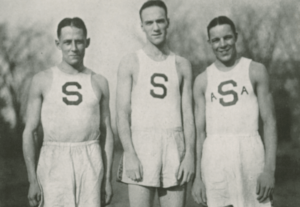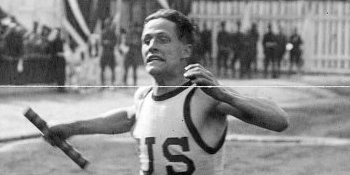- NUMBER OF PENN STATERS COMPETING: 2
- NUMBER OF PENN STATERS IN ALL ROLES: 2
- NUMBER OF OLYMPIC ALTERNATES: 1
Penn State’s track and field team has been one of the most prolific programs within the athletic department in terms of qualifying Nittany Lions for the Olympics. A trio of Penn State stars played a prominent role both in launching the track and field squad in State College to prominence as well as bolstering the American efforts in Belgium during the 1920 Olympics.
Profiles: Larry Shields, Harold Barron, and Alan Helffrich

After a 12-year absence from qualifying anyone to participate in the Olympics, Penn State was represented in full force for the 1920 summer games in Antwerp. Harold Barron spent two years competing for the Nittany Lions in the high hurdles and high in 1916 and 1917 before serving for four years during and after World War I as a first lieutenant in the Army Ordnance Reserve Corps. He made his Olympic debut in Belgium, claiming a silver medal in the 110-meter hurdles.
After his military service and taste of Olympic glory, Barron returned to State College and competed on the Penn State track and field team during his final two years of undergraduate study. Barron was the team captain during his senior year, leading a strong squad that included several other Olympians. After college, Barron went on to coach at Mercersburg Academy and Cascadilla School (NY) before taking up an appointment as head coach at Georgia Tech from 1927 to 1930.
Larry Shields had an even more successful Olympics experience in Antwerp. Like Barron, Shields had served in the armed forces during World War I. The Navy man beat out Harold Cutbill in a late-race sprint just to claim a U.S. qualifying spot for the 1500-meter race in Antwerp. The Penn Stater made the most of his opportunity, racing for a bronze medal in Belgium. Shields also served on the 3000-meter relay team that won gold, but did not score in the final race to earn a medal of his own in the event.
After his Olympic exploits were in the rearview mirror, Shields went on to wear a number of hats — biology teacher, coach, alumni director, and member of the Board of Trustees — over the course of nearly four decades at Philips Andover Academy.
Alan Helffrich traveled with the U.S. Olympic track and field team in 1920 to Belgium, serving as an alternate in the 4×400-meter relay. Though he never saw the track in Antwerp, Helffrich was ultimately the most successful Olympian of the Nittany Lions trio when he returned to the Olympics four years later in Paris shortly after his 1924 graduation from Penn State. In France, Helffrich anchored the 4×400-meter relay team to the gold medal in a new world-record time.
Upon his return to the United States, Helffrich continued to break world records at both 500 meters and 800 meters. Helffrich spent six decades working in the paper industry and enjoyed the distinction for many years as the oldest living Olympian until his passing in 1994.
SOURCES AND ADDITIONAL READING
- “Alan Helffrich.” Olympics.com. https://olympics.com/en/athletes/alan-helffrich.
- “Alan Helffrich, 93, ’24 Olympic Winner.” Tampa Bay (FL) Times. February 6, 1994. https://www.tampabay.com/archive/1994/02/06/alan-helffrich-93-24-olympic-winner/.
- Ferry, Lawrence. “Record Breaking Season for Indoor Track Stars.” Scranton (PA) Republican. April 9, 1925. 20.
- “Georgia Tech Men’s and Women’s Track and Field Guides.” Georgia Tech Archives and Special Collections. UP012. https://finding-aids.library.gatech.edu/repositories/2/resources/351.
- “Harold Barron.” Olympics.com. https://olympics.com/ko/athletes/harold-barron.
- “Larry Shields.” Sports Reference. https://web.archive.org/web/20200417171502/https://www.sports-reference.com/olympics/athletes/sh/larry-shields-1.html.
- “‘Larry’ Shields to Train for Olympics.” Hartford (CT) Courant. May 5, 1924. 15.
- “A New Olympics Plan.” Kansas City (MO) Star. April 25, 1928. 19.
- “Penn State’s Olympic Men.” 1923 LaVie. State College, PA: Pennsylvania State University, 1922. 431.
